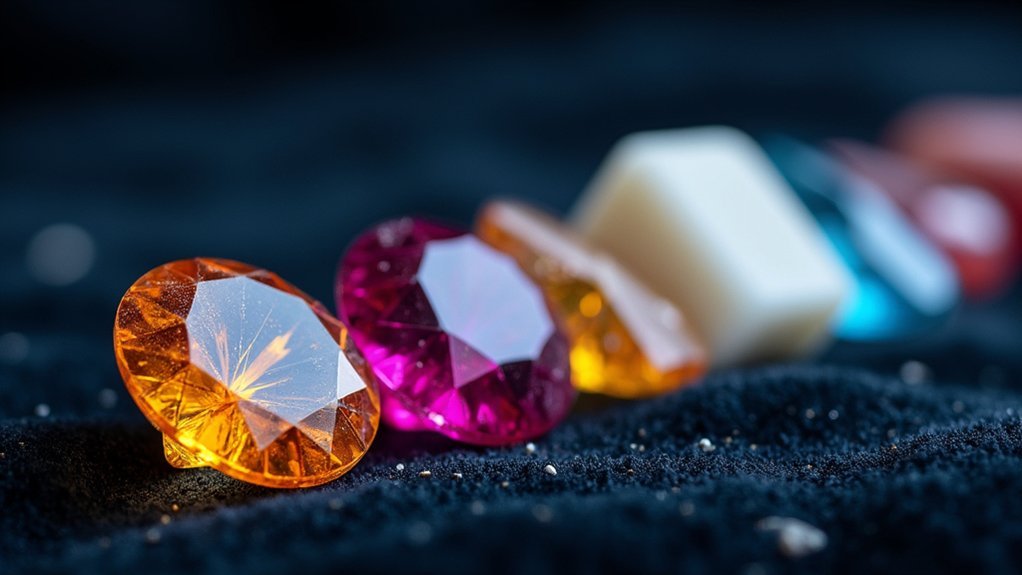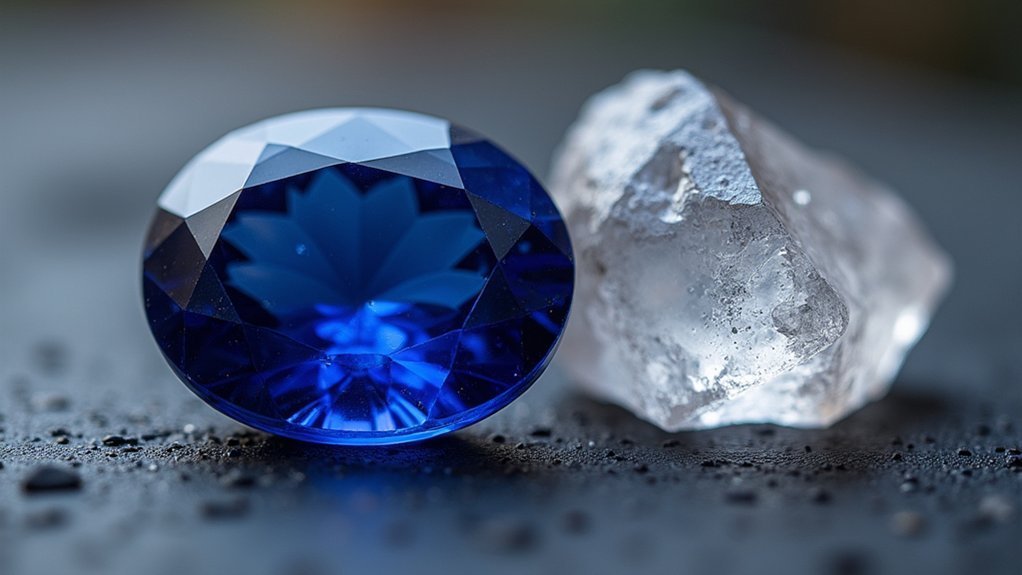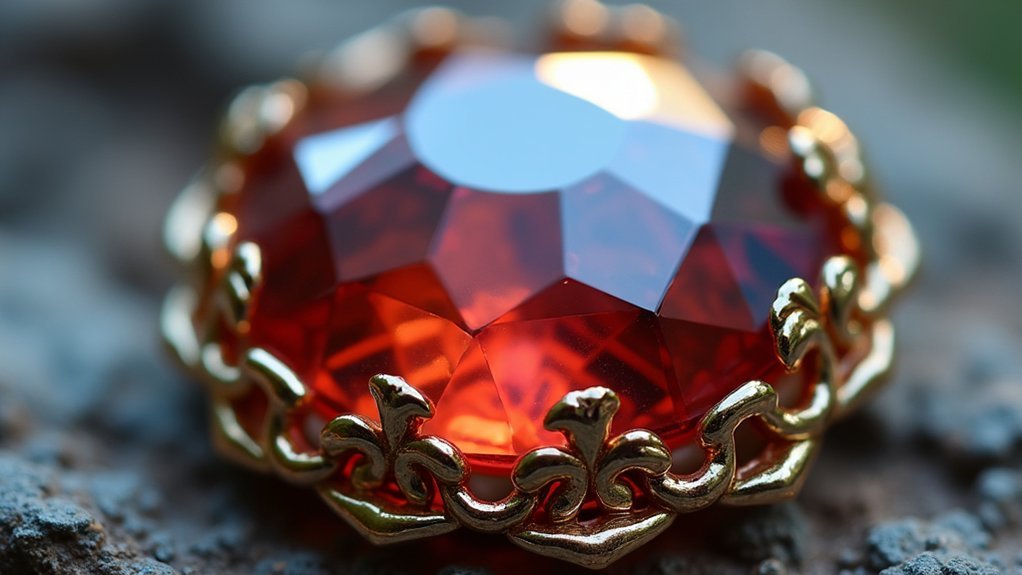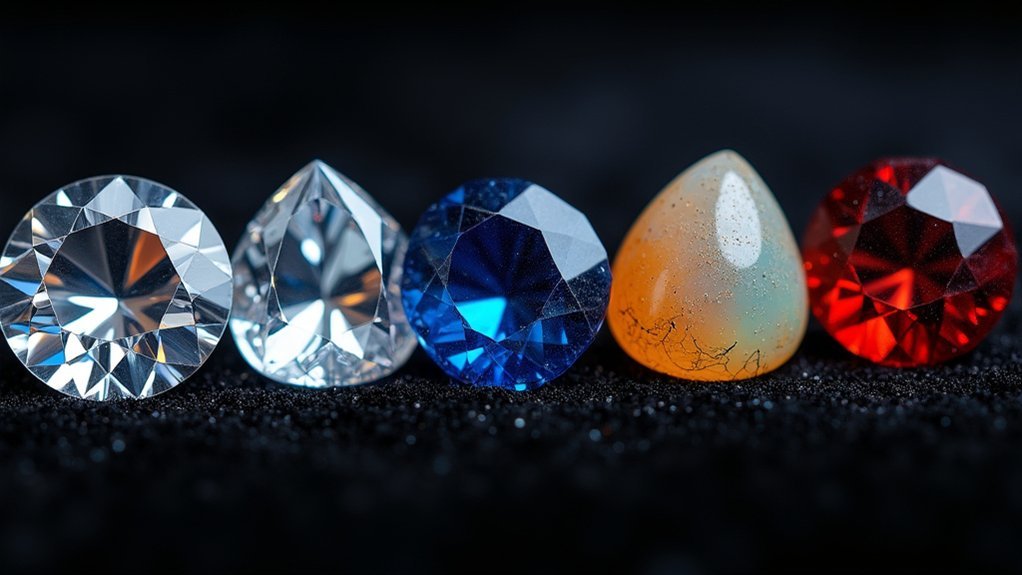A gemstone’s suitability for jewelry depends primarily on its hardness (7+ on the Mohs scale is ideal for daily wear) and tenacity (resistance to breaking). While diamonds rank highest at 10, they can still chip due to their perfect cleavage. Sapphires and rubies (9) offer excellent durability with better impact resistance. You’ll want to evaluate both factors plus appropriate protective settings when choosing gems that will maintain their beauty through years of wear.
Understanding the Mohs Scale: From Talc to Diamond

When selecting gemstones for jewelry, understanding their hardness is essential for making informed decisions about durability and wearability. The Mohs scale, created by Friedrich Mohs in 1812, provides a reliable framework for evaluating gemstone durability by ranking minerals from 1 (talc) to 10 (diamond) based on scratch resistance.
This non-linear scale works on a simple principle: each mineral can scratch those ranked below it while being scratched by those above. The differences between numbers aren’t equal—diamond is actually four times harder than corundum (9), not just 10% harder.
For everyday wear, you’ll want gemstones higher on the scale. Diamonds (10) and sapphires (9) excel in rings and bracelets that face constant contact, while softer stones might better suit pendants or earrings.
Everyday Wear and Tear: How Dust Affects Gemstones
The real-world impact of the Mohs scale becomes apparent when we consider an often overlooked threat to your gemstone jewelry: everyday dust.
Household dust contains quartz particles with a Mohs hardness of 7 to 7.5—tough enough to scratch many popular gemstones during routine cleaning or daily wear.
Soft gemstones like opals and pearls are particularly vulnerable, quickly accumulating microscopic scratches that diminish their polish and beauty.
This explains why hardness matters so much in selecting jewelry for regular use. While you can wear harder gemstones confidently, softer options require careful handling to avoid damage from dust exposure.
If you’ve invested in softer stones, implement preventive cleaning measures and consider limiting their wear to special occasions, keeping them beautiful and scratch-free for years to come.
Beyond Hardness: The Role of Tenacity in Gemstone Durability

Despite being essential, hardness tells only half the story when evaluating a gemstone’s durability for jewelry. Tenacity—a stone’s resistance to breaking upon impact—plays an equally significant role in determining long-term wearability.
Hardness without tenacity is like strength without flexibility—both qualities must balance for truly enduring gemstone jewelry.
You might be surprised to learn that diamonds, despite their supreme hardness (10 on Mohs scale), possess perfect cleavage that makes them brittle and susceptible to shattering when struck forcefully.
Contrast this with jade, which ranks only 6-7 in hardness but boasts exceptional toughness due to its fibrous structure.
When selecting gemstones for everyday jewelry, consider both properties. Gemstones with high hardness but poor tenacity (like emeralds) may chip easily, while tougher stones withstand impacts better.
Understanding this balance helps you choose pieces that maintain their beauty through years of wear.
Cleavage Properties: Why Some Hard Gems Still Break Easily
While diamonds boast a perfect 10 on the Mohs scale, you’ll be surprised to learn they’ve perfect cleavage planes that can cause them to shatter if struck correctly.
This vulnerability stems from their molecular structure, which creates specific split points where the stone is prone to breaking.
Understanding these cleavage properties is essential when you’re choosing or wearing diamond jewelry, as even the hardest gemstone on earth has its weakness.
Diamond’s Fatal Flaw
Many jewelry enthusiasts are shocked when they discover that diamonds, scoring a perfect 10 on the Mohs hardness scale, can suddenly shatter with a single blow. This vulnerability stems from diamond’s perfect cleavage planes—structural weaknesses in the crystal that allow it to split cleanly when struck at specific angles.
| Factor | Impact on Diamonds | Protection Strategy |
|---|---|---|
| Cleavage Planes | Creates splitting vulnerability | Avoid setting with exposed edges |
| Crystal Structure | Allows breaking along planes | Choose protective settings |
| Impact Direction | Can shatter if hit at wrong angle | Wear with care during activities |
| Internal Flaws | Weakens overall structure | Select diamonds with fewer inclusions |
When designing diamond jewelry, these cleavage properties must be considered carefully. Your diamond’s impressive hardness doesn’t guarantee toughness—it can resist scratching while remaining susceptible to breakage.
Perfect Split Points
The misleading nature of gemstone hardness often surprises jewelry owners when their “hard” stones suddenly crack or chip. This paradox stems from a property called cleavage—a gemstone’s tendency to split along specific planes within its crystal structure.
While the Mohs Hardness Scale ranks resistance to scratching, it doesn’t measure a stone’s ability to endure impact. Diamonds exemplify this contradiction perfectly: despite rating 10 on the scale, their perfect cleavage makes them surprisingly vulnerable to breaking when struck at precise angles.
When selecting gemstones used in jewelry, consider both hardness and cleavage properties. Sapphire and ruby (Mohs 9) offer excellent durability because they lack the perfect cleavage planes that compromise diamonds.
Understanding these split points helps you choose gems that will truly last—not just resist scratches but also withstand the bumps of daily wear.
Protective Settings: Enhancing a Gemstone’s Longevity

You’ll need to shield vulnerable gemstones with protective metal settings that match their specific fragility.
Bezel settings completely encase brittle stones, offering maximum protection against impacts, while basket prongs provide both security and visibility for moderately durable gems.
Your setting choice directly impacts your jewelry’s longevity, as even hard gemstones with cleavage planes require thoughtful mounting to withstand everyday wear.
Shield With Metal
Protecting your gemstones effectively often comes down to how they’re set in metal. The right protective settings can greatly enhance a gemstone’s longevity, particularly for daily wear items like engagement rings.
Even harder gemstones on the mineral hardness scale benefit from thoughtful metal shields that minimize wear and tear.
Bezel settings completely surround stones with metal, offering maximum protection against impacts and abrasions. However, if you prefer more light exposure for brilliance, properly designed prong settings can provide security without sacrificing sparkle.
For stones with lower hardness or pronounced cleavage planes, like emeralds, more thorough protection is essential.
Remember that any setting requires regular inspection to guarantee your gemstone remains secure. An open bezel might be visually striking, but consider whether it provides adequate protection for your particular stone.
Tailor For Fragility
When selecting settings for more delicate gemstones, tailoring your approach to each stone’s unique vulnerabilities becomes essential for longevity.
Protective settings like bezels shield fragile stones from impacts, considerably reducing chipping risks. For stones that aren’t hard enough for daily wear, consider how much exposure is appropriate—open bezels might increase vulnerability.
Balance is key with prong settings; basket prongs offer security while maintaining visibility.
Understanding a gemstone’s cleavage planes helps you choose settings that prevent splitting along natural weakness lines.
For softer gemstones like opals and pearls, location matters as much as setting style. You’ll extend their lifespan by featuring them in earrings or pendants rather than rings, where they face constant abrasion.
Your awareness of a stone’s ability to scratch and break determines the most suitable protective environment for its beauty.
Best Gemstones for Different Jewelry Types
Selecting the right gemstone for your jewelry involves more than just color preference; it requires understanding how hardness impacts durability in different wear situations.
The hardest mineral, diamond (10), along with ruby and sapphire (9), are top quality choices for rings and bracelets that face daily abrasion. It’s important to understand that these corundum varieties withstand constant contact without losing their luster.
For earrings and pendants, you can confidently choose softer stones like opals (5-6) and pearls (3-4) since they’ll face minimal impact.
Gemstones rating 7 or higher, including garnet and topaz, offer versatility for most jewelry types. When choosing stones for engagement rings, stick with diamonds, sapphires, or rubies to guarantee they remain beautiful through decades of wear.
Caring for Gemstones Based on Their Hardness Rating

Proper care of your gemstone jewelry starts with understanding the Mohs hardness scale and how it affects maintenance requirements.
Gemstones with a hardness of 7 or higher, like ruby and sapphire, require less protection during daily wear but still need regular maintenance to preserve their brilliance.
For softer gemstones (3-4 on the Mohs scale) such as pearls and opals, you’ll need protective settings and gentler care routines.
Store these pieces separately to prevent scratching and clean them with mild solutions only.
Even diamond, with its perfect 10 hardness rating, isn’t indestructible—its perfect cleavage makes it susceptible to chipping upon impact.
Establish cleaning routines based on your gemstone’s hardness, and you’ll maintain your jewelry’s beauty and value for generations.
Frequently Asked Questions
What Gemstones Are Hard Enough for Daily Wear?
For daily wear, you’ll want gemstones with Mohs hardness of 7+. Diamonds (10), sapphires and rubies (9), as well as topaz and garnets (7-8) are durable choices that won’t easily scratch during your everyday activities.
What Hardness Is Good for Jewelry?
You’ll want gemstones with a hardness of 7 or higher on the Mohs scale for everyday jewelry. Diamonds (10), rubies and sapphires (9) are excellent choices that won’t easily scratch during daily wear.
How Hard Should a Gemstone Be for a Ring?
For a ring, you’ll want gemstones with a Mohs hardness of at least 7. Diamonds (10), sapphires and rubies (9) are ideal choices, while softer stones like opal won’t withstand daily wear well.
What Is the Hardness Scale for Gemstones?
The Mohs hardness scale ranks gemstones from 1 (softest) to 10 (hardest). You’ll find diamond at 10, corundum at 9, and quartz at 7. Most jewelry-suitable gems rate 7 or higher.
In Summary
When selecting gemstones for jewelry, you’ll need to take into account more than just the Mohs hardness. You should look at tenacity, cleavage properties, and intended wear. Diamonds aren’t your only option—many gems above 7 on the Mohs scale will serve you well in daily wear. With proper settings and care routines tailored to your stone’s specific properties, you’ll enjoy your gemstone jewelry for years to come.





Leave a Reply